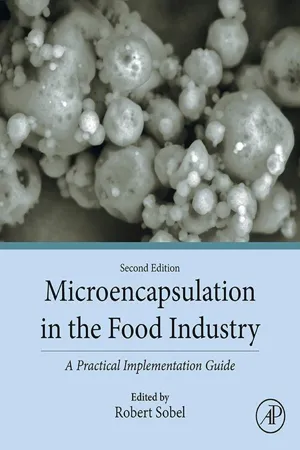
- 624 pages
- English
- ePUB (mobile friendly)
- Available on iOS & Android
About This Book
Microencapsulation in the Food Industry: A Practical Implementation Guide, Second Edition continues to focus on the development of new microencapsulation techniques for researchers and scientists in the field. This practical reference combines the knowledge of new and novel processing techniques, materials and selection, regulatory aspects and testing and evaluation of materials. It provides application specific uses of microencapsulation as it applies to the food and nutraceutical industries. This reference offers unique solutions to some very specific product needs in the field of encapsulation.
This second edition highlights changes in the industry as a result of a field that has traversed from the micro scale level to nano-scaled encapsulation and includes two new chapters, one on regulatory, quality, process scale-up, packaging, and economics and the other on testing and quality control.
- Includes new characterization methodologies to understand chemical and physical properties for functionality of the final microencapsulated material
- Presents the latest research and developments in the area of nano-scale encapsulation and intelligent packaging
- Provides new testing tools to assess products containing microencapsulated actives
Frequently asked questions
Information
Table of contents
- Cover image
- Title page
- Table of Contents
- Copyright
- Dedication
- List of contributors
- About the editor
- Foreword
- Preface
- Chapter 1. Introduction to microencapsulation and controlled delivery in foods
- Chapter 2. Review of microencapsulation patent landscape for the food and beverage industries
- Chapter 3. Factors and mechanisms in microencapsulation
- Chapter 4. Applications of mass and heat transfer in microencapsulation processes
- Chapter 5. Overview of microencapsulation process technologies
- Chapter 6. Atomization and spray drying processes
- Chapter 7. New advances in spray-drying processes
- Chapter 8. Fluid bed coating-based microencapsulation
- Chapter 9. Extrusion-based microencapsulation for the food industry
- Chapter 10. Spheronization, granulation, pelletization, and agglomeration processes
- Chapter 11. Annular nozzle in laminar flow encapsulation processes
- Chapter 12. Monodispersed microencapsulation technologies
- Chapter 13. Microencapsulation by complex coacervation processes
- Chapter 14. Application of liposomes in the food industry
- Chapter 15. Nanoencapsulation in the food industry
- Chapter 16. Selection of materials for microencapsulation
- Chapter 17. Starch-based materials for microencapsulation
- Chapter 18. Use of milk proteins for encapsulation of food ingredients
- Chapter 19. Natural and clean label ingredients for microencapsulation
- Chapter 20. Gelatin and other proteins for microencapsulation
- Chapter 21. Hydrocolloids and gums as encapsulating agents
- Chapter 22. Fats and waxes in microencapsulation of food ingredients
- Chapter 23. Yeast cells and yeast-based materials for microencapsulation
- Chapter 24. Testing tools and physical, chemical, and microbiological characterization of microencapsulated systems
- Chapter 25. Stability characterization and sensory testing in food products containing microencapsulants
- Chapter 26. Regulatory considerations of encapsulation used in the food industry
- Chapter 27. Novel concepts and challenges of flavor microencapsulation
- Chapter 28. Flavor release and application in chewing gum and confections
- Chapter 29. Protection and delivery of probiotics for use in foods
- Chapter 30. Micro- and nanoencapsulation of omega-3 and other nutritional fatty acids: challenges and novel solutions
- Chapter 31. Microencapsulation of vitamins, minerals, and nutraceuticals for food applications
- Chapter 32. Development and scale-up of microencapsulation-based technology for multimicronutrient fortification of salt
- Chapter 33. Encapsulation for taste modification
- Chapter 34. Microencapsulated enzymes in food applications
- Chapter 35. Advances in lecithin-based nanoemulsions within the animal and human nutritional markets
- Index